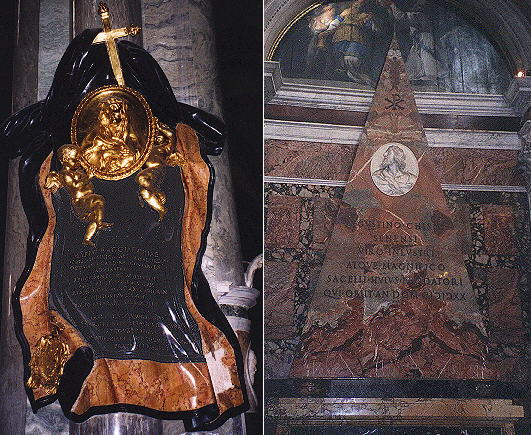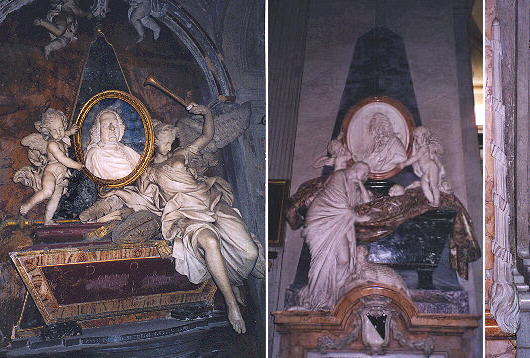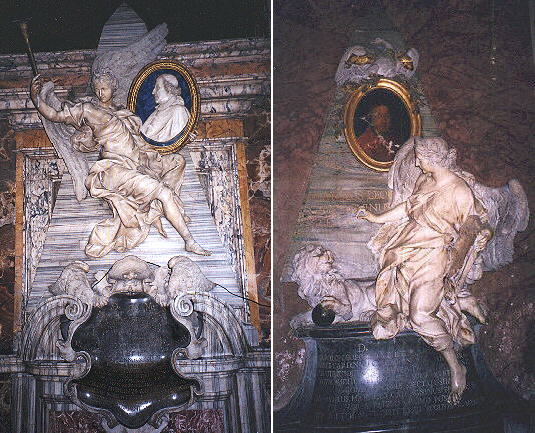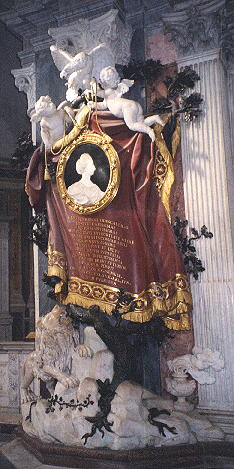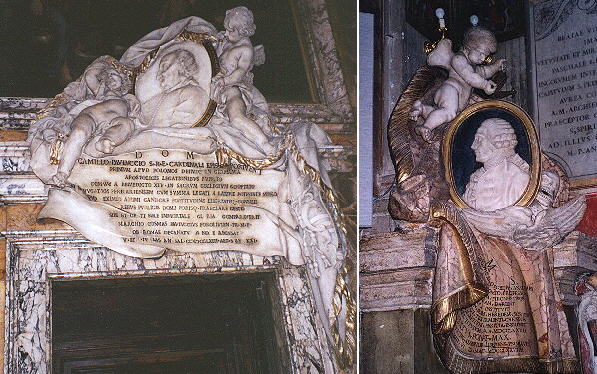  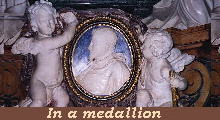 In a medallion In a medallionMonument to Cardinal Ludovisi by Pierre Legros in S. Ignazio This page deals with baroque funeral monuments where the dead are shown in a medallion, without
a representation of Death holding the medallion: these monuments are dealt with in a separate page: Memento Mori.
The Monument to Maria Raggi on a pillar of S. Maria sopra Minerva introduced the concept
of pictorial sculpture which Bernini developed in many other subsequent works. The use of color and of drapes swelled by a sort of internal
wind will appear again in the Monument to Alexander VII and
in the statue of Constantine.
Michel Rénè Slodtz, known in Rome as Michelangelo Slodtz, was one of the many French artists
who worked in Rome during the XVIIth and XVIIIth centuries. His Monument to Alessandro Capponi in S. Giovanni dei Fiorentini is influenced
by both of Bernini's monuments. The monument shows also a little skull and on the base a torch upside down, a symbol
of death which was replacing the more direct representations of the XVIIth century. The monument was designed by Ferdinando Fuga a Florentine architect
who worked in Rome, chiefly for the Florentine Pope Clemens XII. It was not uncommon for sculptors to be asked to work
on a monument designed by an architect.
His monument to Cardinal Calcagnini in S. Andrea delle Fratte with a statue of an angel writing on the pyramid is similar to a monument by Bernardo Cametti in Palestrina, which you can see in the background of this page. Paolo Posi, an architect who worked in the second half of the XVIIIth century, can be considered the last baroque artist.
Although in the last part of the XVIIIth century, as a result of the Neoclassicist movement, the name Bernini became synonymous with bad taste, still some monuments continued to be designed following his examples.
Tommaso Righi and Raffaele Secini are hardly mentioned in any history of art, most likely because they continued to use baroque images in an environment fully converted to Neoclassicism, as their Monuments to the Cardinal Camillo Merlini Paolucci in S. Marcello al Corso and to the anatomist Pietro Giavota in S. Spirito in Sassia clearly show. Other pages dealing with Baroque sculpture: Statues in the act of praying Representation of Death in Baroque sculptures Baroque Angels Three chapels by Gian Lorenzo Bernini Three busts by Alessandro Algardi Baroque Monuments to the Popes Baroque High Reliefs Statues Close to Heaven Embittered Andrew (the statues in St. Peter's octagon) Laughing Masks Playing with Colours See also my List of Baroque Architects and my Directory of Baroque Sculpture.
Go to my Home
Page on Baroque Rome or to my Home Page on Rome
in the footsteps of an XVIIIth century traveller.
|
All images © 1999 - 2003 by Roberto Piperno. Write to romapip@quipo.it
